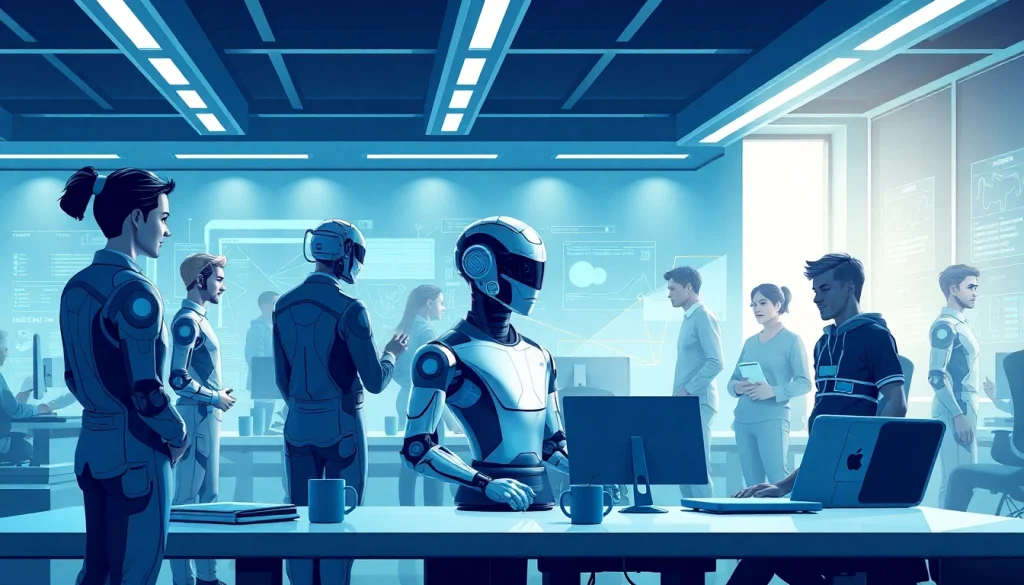
1. Introduction to Agentic Human AI
In an age where technology permeates every aspect of our lives, the concept of Agentic Human AI emerges as a transformative force, redefining how we understand artificial intelligence (AI) and its applications. This innovative form of AI operates autonomously, enabling machines to make decisions and take actions with minimal human intervention. Such a capability holds immense potential for enhancing productivity and efficiency across various sectors.
1.1 Definition and Scope
Agentic Human AI refers to AI systems that possess a greater degree of autonomy compared to traditional AI, capable of performing tasks and making decisions based on learned information and past experiences. It encapsulates machine-learning algorithms that leverage vast datasets to imitate human decision-making processes while executing complex tasks without constant oversight. The scope of Agentic Human AI is wide, extending across industries like healthcare, finance, and entertainment, where systems can operate independently to achieve defined goals.
1.2 Historical Context
The evolution of AI has traversed several phases, from rule-based systems that merely followed predefined algorithms to the emergence of machine learning models that learn from data. The historical context of Agentic Human AI can be traced back to advancements in neural networks and deep learning, which have allowed machines to analyze vast amounts of data and recognize intricate patterns. As these technologies matured, the concept of machines operating autonomously became feasible, leading to the birth of Agentic AI systems designed to perform tasks independently.
1.3 Purpose and Importance
The purpose of Agentic Human AI lies in its ability to execute tasks more efficiently than human operators, minimizing errors, and optimizing resource allocation. Its importance is underscored by its capabilities in performing routine and repetitive tasks that drain human productivity, thereby allowing individuals to focus on more strategic initiatives. Furthermore, as industries grapple with challenges like workforce shortages and overwhelming data-processing needs, Agentic Human AI holds the key to achieving operational success in a rapidly evolving technological landscape.
2. The Mechanisms of Agentic Human AI
2.1 Autonomous Decision-Making
At the core of Agentic Human AI lies autonomous decision-making. Unlike traditional AI, which typically requires explicit instructions to perform tasks, Agentic AI can analyze various factors and choose the best course of action based on its environment. This capability enables AI to handle ambiguity and make decisions that align with its goals, mimicking human-like judgment. For instance, in financial trading, Agentic AI can analyze market trends and execute trades autonomously to maximize profits without human intervention.
2.2 Learning and Adaptability
The learning mechanisms employed in Agentic Human AI are fundamental to its effectiveness. These systems utilize advanced algorithms to process data, identify patterns, and adapt to new information. Reinforcement learning, for example, allows Agentic AI to learn from feedback, enabling it to improve its decision-making over time. This adaptability is crucial in dynamic environments, such as healthcare, where AI can learn from patient outcomes to enhance treatment protocols continually.
2.3 Interaction with Human Users
Regardless of their autonomous capabilities, Agentic Human AI systems are designed to interact with human users effectively. This interaction can occur through natural language processing, allowing AI to communicate and collaborate seamlessly with people. In customer service applications, for example, Agentic AI can manage inquiries autonomously while adapting its responses based on user sentiment and behavior, fostering a more engaging and personalized experience.
3. Applications of Agentic Human AI in Different Industries
3.1 Healthcare Innovations
Agentic Human AI is revolutionizing the healthcare industry through applications that range from diagnostics to patient management. By utilizing vast amounts of medical data, AI systems can autonomously analyze symptoms, predict diseases, and recommend treatments. For instance, AI-driven platforms can process imaging data to identify anomalies in scans more efficiently than human radiologists. This capability not only speeds up diagnosis but also enhances treatment accuracy, showcasing the substantial benefits of Agentic AI in a field where precision is critical.
3.2 Business Process Optimization
In the realm of business, Agentic Human AI is employed to streamline operations and enhance decision-making. By autonomously analyzing logistics, supply chain dynamics, and customer behavior, these systems can optimize resource allocation, reduce costs, and increase overall operational efficiency. Financial institutions, for example, utilize Agentic AI for fraud detection, where the system learns from transaction patterns to detect anomalies and raise alerts autonomously, thus safeguarding assets and reducing risk.
3.3 Educational Transformations
In education, Agentic Human AI is ushering in a new era of personalized learning. AI systems can assess students’ learning styles and performance patterns to create tailored educational pathways that cater to individual needs. By continuously adapting the curriculum based on student feedback and performance metrics, Agentic AI fosters an engaging and effective learning environment. Furthermore, intelligent tutoring systems provide instant feedback and assistance, facilitating a more interactive learning experience.
4. Challenges and Ethical Considerations
4.1 Data Privacy Issues
As Agentic Human AI systems collect and process vast amounts of personal data, concerns about data privacy become paramount. Ensuring compliance with regulations such as GDPR is essential for protecting user information. Organizations must implement robust data security measures and establish transparent data usage policies to mitigate risks associated with privacy violations. Additionally, educating users about data usage is vital to fostering trust in AI systems.
4.2 Accountability and Transparency
The autonomous nature of Agentic AI raises significant questions regarding accountability and transparency. In scenarios where AI systems make decisions that lead to significant outcomes—whether positive or negative—determining liability can be complex. Developers and organizations must prioritize transparency in AI systems, ensuring users understand how decisions are made and providing mechanisms for recourse in the event of errors or grievances.
4.3 Managing Human-AI Collaboration
Despite its potential, Agentic Human AI is not without challenges. The balance between AI autonomy and human oversight must be meticulously managed to ensure effective collaboration. Organizations must clearly define the roles of AI and human employees, emphasizing the complementary nature of their capabilities. Training programs can play a crucial role in preparing individuals to work alongside AI systems, aligning expectations and fostering effective collaboration that leverages the strengths of both parties.
5. The Future of Agentic Human AI
5.1 Emerging Trends
The landscape of Agentic Human AI is continuously evolving, with several emerging trends on the horizon. Developments in explainable AI (XAI) aim to enhance the transparency of decision-making processes, making AI systems more understandable to users. Additionally, the integration of AI across various platforms will enable a more cohesive experience, where systems can seamlessly interact with one another to provide comprehensive solutions across multiple domains.
5.2 Predicted Impact on Employment
The rise of Agentic Human AI raises valid concerns regarding the potential disruption of job markets. While some roles may become obsolete due to automation, new opportunities will likely emerge as businesses adapt to these advanced technologies. It is crucial for workforce development programs to incorporate training in AI literacy and technical skills, ensuring that employees can transition into new roles that focus on managing and collaborating with AI systems. Thus, the impact of Agentic AI on employment will depend largely on proactive strategies implemented by organizations and policymakers.
5.3 Vision for Human-AI Synergy
The vision for the future of Agentic Human AI centers on fostering synergy between humans and machines. By leveraging the strengths of both parties, organizations can create more efficient, innovative, and flexible systems. This partnership enables humans to focus on creativity and critical thinking while delegating mundane tasks to AI. The ultimate goal is to enhance productivity through collaboration, unlocking new paradigms of efficiency, creativity, and human capability.





